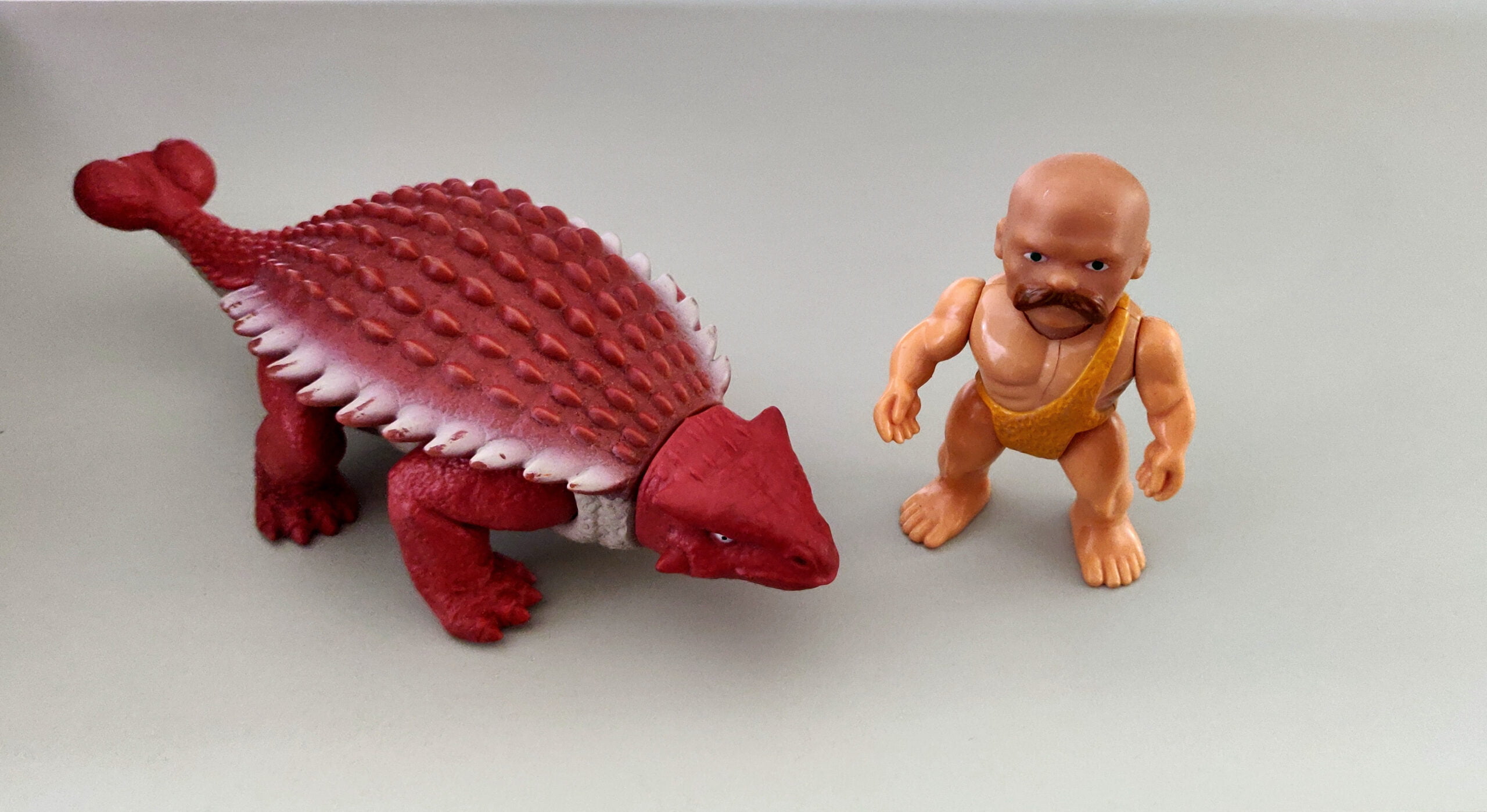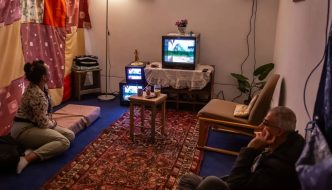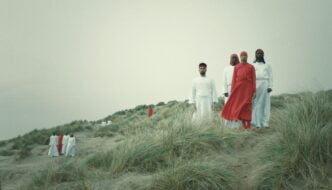
The Ankylosaurus and the Caveman. Playskool’s ‘Definitely Dinosaurs’ range, released in 1987.
Like most nerdy kids, from a very early age I became obsessed with dinosaurs. I think films like Universal Pictures’ 1988 animation epic The Land Before Time and other paleontological pop culture of the same decade, including the alliterative Saturday morning cartoon rivals Dink, the Little Dinosaur and Denver, the Last Dinosaur, were to blame. Of course, these cinematic and weekend televisual experiences were used by toy manufacturers to shift as much of their mass-produced dino-inspired merchandise as possible, and I was one of their core demographic. My bedroom floor was strewn with all manner of moulded plastic dinosauria, including a much-cherished ankylosaurus, which anachronistically came as a pair with a moustachioed caveman that looked reminiscent of a prehistoric Tom of Finland beefcake.
It’s little wonder then, given any opportunity I’d use crayons, felt tip pens, and poster paints to try and faithfully recreate the dinosaur form on paper. With a little help from my Nan, I made the leap from 2D to 3D with an unlikely ensemble of materials including potatoes, pipe cleaners, and used matches – as a smoker my Nan would save her struck matches for this very purpose. Together we’d build models of yet to be discovered dinosaur species using a potato as the body, and used matches and pipe cleaners as various appendages. I soon graduated from potatoes to paper mache thanks to my Mum’s own formidable crafting skills. Together we made a pterodactyl from a wire hanger, toilet roll tubes, and multiple copies of the Liverpool Echo. Morphologically speaking, these models were more likely to make it into a Godzilla film than World Museum Liverpool, but it was the care, collaboration, and creativity involved in their construction that was of greatest value.
Not to be too sentimental about it, but these familial and formative experiences, amongst others, continue to underpin and inform my understanding and application of co-creation as a creative freelancer. For those not up to speed with current cultural sector lingo, co-creation in its broadest form involves communities, groups or individuals coming together to jointly develop and deliver creative projects. It’s an approach that arts, culture and heritage organisations have embraced with some gusto over the past several years, and it’s increasingly become a prerequisite of many sector-wide funders that prioritise cultural democracy, participatory decision-making, and the needs of under-served communities. This repositioning has required the cultural sector to dramatically rethink who it serves and how it does it, whilst also exploring and embedding new practices that combine the kind of consideration, cooperation, and craftpersonship I engaged in with my Mum and Nan.
The co-creation that features heavily in current cultural policy is perhaps intended to be a little more sophisticated than the pipe cleaners and potatoes approach, but the principle of enabling communities, particularly under-served communities, to drive decision-making regarding their creative aspirations remains the same. As a Northerner from a working-class overlooked town, I was relieved to see the recent levelling up inquiry report The Case for Culture: What Northern Culture Needs to Rebuild, Rebalance and Recover by the Northern Culture All Parliamentary Group strongly in favour of co-creation as ‘a powerful means of helping communities shape their cultural offer’. Under-served communities should be involved in each and every aspect of developing and delivering their arts, culture, and heritage provision. If they’re in places with limited to virtually no cultural infrastructure, the necessary resources should be made available to support and sustain capacity building.
For cultural capacity building to have the desired effect, unhelpful practices like parachuting, or creative ventriloquism as I like to call it, need to be avoided. I’m not talking about the likes of Rainford’s very own ventriloquist prodigy and Britain’s Got Talent finalist Jaimie Leahey and his avian sidekick Chuck, rather the process of well-intentioned but nevertheless aloof ‘creative visionaries’ temporarily taking up residency in overlooked places, assuming the role of spokesperson on ‘behalf’ of under-served communities, and executing a predetermined master plan. This approach undoubtedly has short-term benefits but it effectively constrains participation to rudimentary and ultimately disempowering forms of consultation, undermining the long-term capacity building that’s needed to underpin community-owned co-creation. It’s the equivalent of an overzealous curator of palaeontology unexpectedly turning up at my Nan’s council flat and indignantly proceeding to flatten our spudusaurus with their expensive scientific model.
Before I’m served with a letter of complaint by The Palaeontological Association, the above scenario is entirely fictitious and I would never accuse palaeontologists of being predisposed to random acts of anti-craft vandalism. However, my point is this: for co-creation to have the electrifying impact on overlooked places that the Northern Culture All Parliamentary Group quite rightly believes it can, those of us with the passion and the necessary expertise, knowledge, and skills to make this happen must do so at the invitation of under-served communities, and with the intention of enabling their creative objectives, opportunities, and outcomes, and not imposing ours. The same is equally true for under-served communities in privileged places with firmly embedded cultural infrastructures and well-established cultural institutions, their agency, consent, and trust must be prioritised, and their participation should begin at project inception and continue with each element of its administration.
In early 2022 I spent some time in Blackpool with the good folk at Aunty Social – an arts and culture community interest company – and learnt all about their indefatigable approach to community-owned co-creation, which is anything but creative ventriloquism. Like Skelmersdale, Blackpool gets a bad rap. There’s no shortage of commentators that are willing to share their ill-informed and often unsolicited opinions about underprivileged northern postcodes and the people who live there. In spite of such attitudes, Aunty Social has been keeping communities in the left-behind neighbourhoods of Blackpool and the Fylde Coast creative since 2011 through a combination of co-creation, collaboration, and activism. Aunty Social’s impressive project portfolio and social impact predate the announcement by the Treasury of the £4.8 billion Levelling Up Fund in 2020 by almost a decade. So for any part of this investment to act as ‘a powerful means of helping communities shape their cultural offer’, it’s Aunty Social and other organisations like it that can provide a tried and tested co-creation model that is aspirational, effective, and inclusive.
If The Land Before Time taught us anything, it’s that with some collaboration, compassion, and conviction we’re capable of improving our situation and surroundings, and with the right resolve and resources, this is precisely how under-served communities in overlooked places can deploy co-creation to their benefit. That said, if the current perception of levelling up is correct, it’s those places without pre-existing cultural capacity or infrastructure that are likely to be overlooked once again in favour of those places that do. Rebalancing this is no mean feat, and it’ll require a long-term commitment to cultural capacity building, but if it can be achieved, the benefits for people in places like my hometown of Skelmersdale would be substantial, just as Aunty Social has been able to demonstrate in Blackpool.
Community-owned co-creation can boost placemaking, increase participation, and support a pipeline of creative talent in places where even contemplating a career in the creative industries or cultural sector is still considered only a pipedream, and sometimes all it takes is a handful of pipe cleaners and a little bit of imagination to get started.
Filed under: Community
Tagged with: arts, Blackpool, co-creation, community, creativity, Culture, dinosaurs, Heritage, palaeontology, Skelmersdale



Comments